You have 0 product(s) in your cart.
Abyss Scuba Diving
Bull Shark Food: Insights Into Diet And Feeding Habits
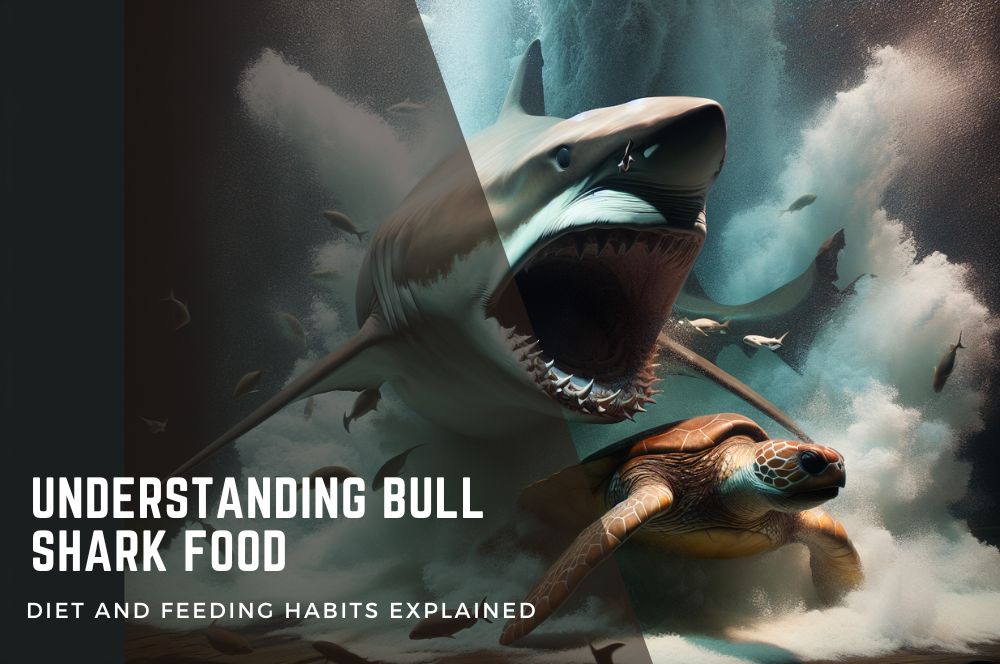
Understanding Bull Shark Food: Diet and Feeding Habits Explained
Bull sharks eat a wide variety of prey such as fish, dolphins, sea turtles, birds, and even other sharks. Their diet is a reflection of their adaptability across different environments, from salty ocean waters to freshwater rivers. This article explores in detail the types of bull shark food they consume and how their feeding habits allow them to thrive in diverse habitats.
Key Takeaways
-
Bull sharks have a highly varied and omnivorous diet, consisting of bony fish, sea turtles, marine mammals, smaller sharks, rays, crustaceans, mollusks, birds, and even terrestrial mammals, which supports their adaptability and survival in diverse environments.
-
Human activities, such as overfishing, habitat destruction, pollution, and fishing practices, pose significant threats to bull sharks by reducing the availability of prey and causing health issues, contributing to their near-threatened status.
-
Bull sharks employ diverse feeding techniques like the bump-and-bite strategy and regurgitation to capture prey and escape predators, demonstrating their adaptability and strategic behaviors in different environments and situations.
Understanding Bull Shark Food: Diet and Feeding Habits Explained
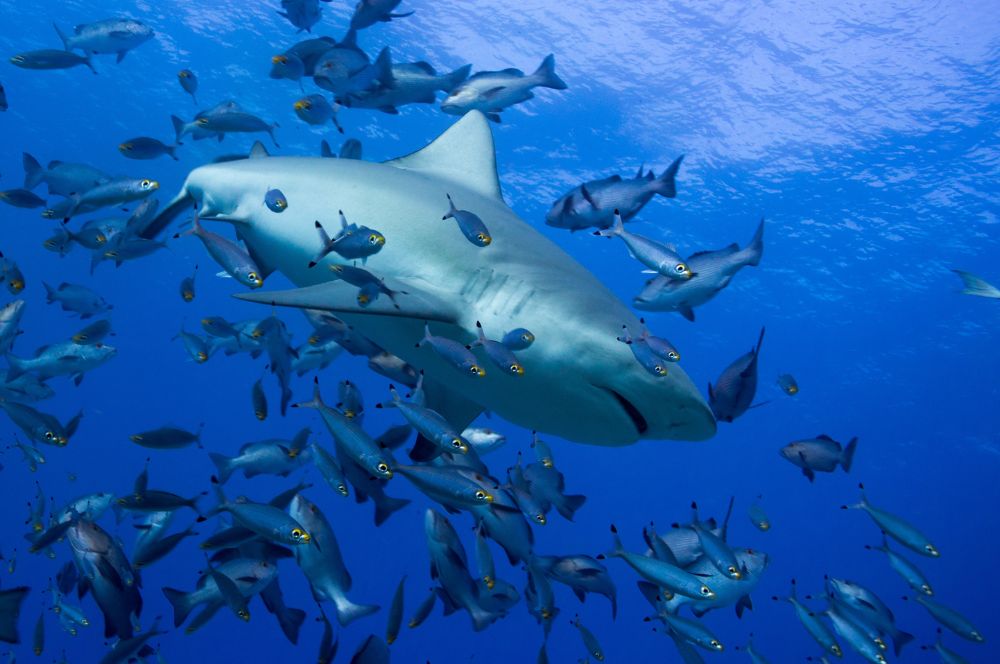
Bull sharks, scientifically known as Carcharhinus leucas, are one of the most widespread and adaptable dangerous shark species. In fact, they are often considered among the most dangerous shark species, alongside tiger sharks. They are found in both saltwater and freshwater environments, from oceans and seas to rivers and estuaries. Their diverse habitat enables them to have an omnivorous diet, feeding on a variety of prey such as other sharks, dolphins, turtles, birds, mollusks, echinoderms, and even terrestrial mammals. This makes them one of the most fascinating species to study in terms of their diet and feeding habits.
The main diet of these animals includes fish, dolphins, sea turtles, rays, birds, and other sharks. They obtain their nutrition primarily from these sources to support their energy needs and growth. However, they are also known for being opportunistic feeders, meaning they will eat almost anything available to them. This includes a wide range of secondary prey items like smaller sharks, rays, crustaceans, mollusks, birds, and terrestrial mammals. This varied diet is crucial for their survival, as it allows them to adapt to different environments and food availability.
Introduction
Bull sharks are a captivating species with a remarkable capacity to thrive in a wide range of habitats, including coastal marine, estuarine, and freshwater environments like the Caloosahatchee River estuary. This adaptability extends to their feeding habits, making their diet as diverse as the environments they inhabit. However, human activities such as hunting, habitat destruction, and pollution pose significant threats to these sharks, leading to their status as near threatened by the International Union for Conservation of Nature.
This exploration into their diet and feeding habits aims to shed light on their complex interactions with their environment and the potential implications of human activities on their survival.
Overview of Bull Shark Diet
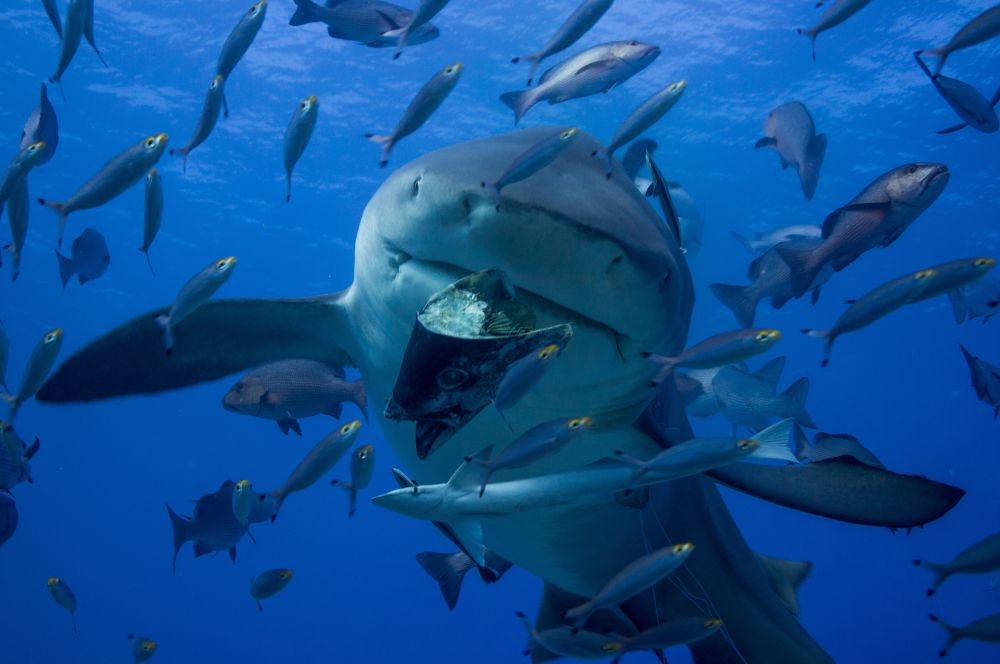
As carnivorous predators, bull sharks have an omnivorous diet rich in variety. This includes other sharks, dolphins, turtles, birds, mollusks, echinoderms, and terrestrial mammals. Their primary diet is composed of fish, dolphins, sea turtles, rays, birds, and other sharks. This varied diet allows them to obtain the nutrients needed for survival. This dietary preference is closely linked to their habitats, as bull sharks typically inhabit shallow waters where they prey on fish, turtles, and birds. In contrast, their cousin, the tiger shark, prefers deeper ocean waters near coral reefs.
This diverse diet allows bull sharks to adapt to a wide range of habitats and food availability. For instance, bull sharks in freshwater environments can survive on a diet primarily consisting of freshwater species, while those in marine environments consume a mix of marine and estuarine species. This adaptability is one of the unique traits of bull sharks, setting them apart from other shark species.
Primary Prey Items

While bull sharks have a broad diet, certain prey items are considered primary due to their frequent occurrence and significant role in the shark’s nutrition. These primary prey items include bony fish, sea turtles, and marine mammals.
Let’s delve into the specifics of each of these prey items.
Bony Fish
Bony fish are a major component of the bull shark’s diet, indicating their significance as primary prey. These fish are abundant in marine environments and provide essential nutrients and energy. The availability of bony fish in various habitats, from freshwater rivers to coastal lagoons and open seas, makes them a readily available food source for bull sharks.
The bull shark’s powerful jaws and sharp teeth enable it to efficiently capture and consume these fish. Whether it’s a solitary hunter in the murky water of a river or an opportunistic feeder among a school of fish in the ocean, the bull shark is perfectly adapted to capture and eat bony fish, making it a formidable predator in both freshwater and marine environments.
Sea Turtles
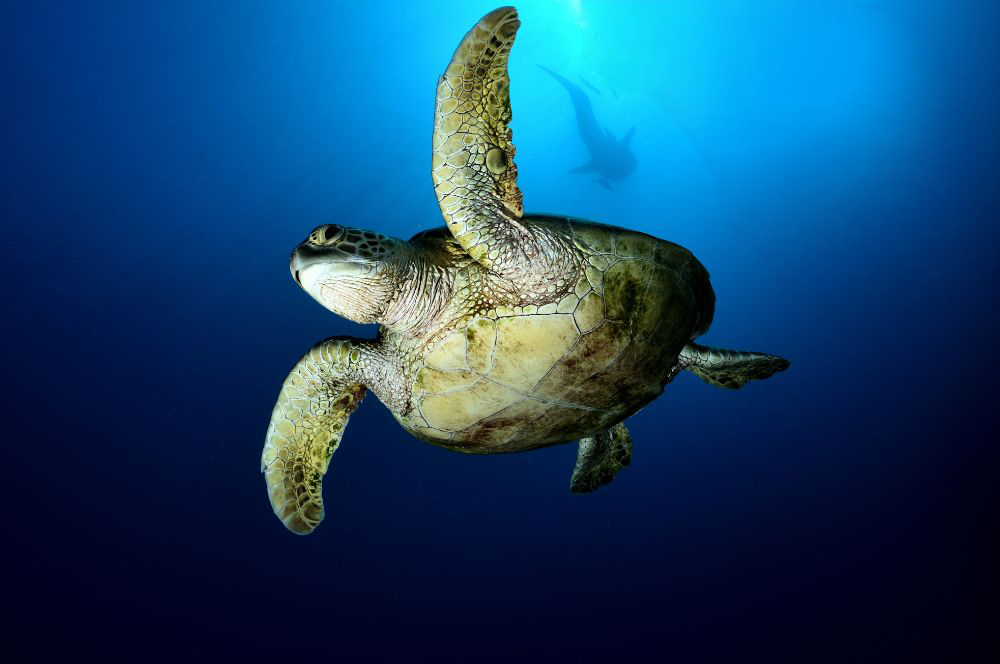
Sea turtles are another significant prey item in the diet of bull sharks. These sharks use their powerful jaws to break through the turtles’ hard shells, a feat few other predators can accomplish. This is a testament to the strength and power of the bull shark, further establishing its position as a top predator in its ecosystem.
Bull sharks may attack sea turtles by biting their flippers first, immobilizing them before consuming. This hunting technique demonstrates the bull shark’s strategic thinking and adaptability, showcasing its ability to exploit the weaknesses of its prey. Whether in the shallow coastal waters near breeding season or in the deeper waters where sea turtles spend most of their lives, bull sharks are a significant threat to these endangered species.
Marine Mammals
Marine mammals, such as dolphins, seals, and sea lions, form another important part of the bull shark’s diet. Bull sharks have been observed preying on dolphins, showcasing their ability to hunt large marine mammals. This demonstrates their versatility as predators and their position at the top of the food chain.
Bull sharks also prey on:
-
Fish
-
Dolphins
-
Turtles
-
Birds
-
Crustaceans
-
Seals and sea lions, especially in coastal areas where these animals are abundant
The ability to capture and consume such large and powerful prey highlights the strength and agility of bull sharks. It also underlines their importance as apex predators in maintaining the balance of marine ecosystems.
Secondary Prey Items
In addition to their primary prey, bull sharks also consume a variety of secondary prey items. These include smaller sharks and rays, crustaceans and mollusks, and even birds and terrestrial mammals.
Let’s explore each of these prey items in more detail.
Smaller Sharks and Rays
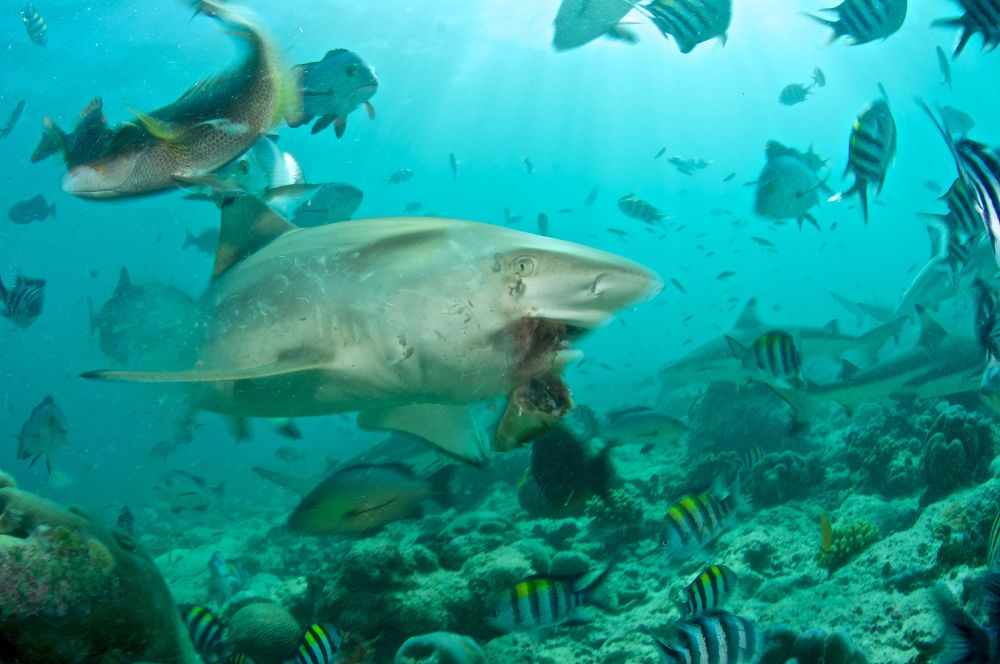
Bull sharks are known to prey on other shark species, including smaller individuals of their own kind. This demonstrates their opportunistic feeding behavior and further reinforces their position as a top predator. They are also known to prey on rays, a behavior that showcases their competitive nature in their habitats.
By preying on smaller sharks and rays, bull sharks help regulate these species’ populations, contributing to the overall balance of marine ecosystems. This predatory behavior also highlights the competitive nature of marine environments, where survival often means eating or being eaten. Understanding the role of reproduction bull sharks in these ecosystems is crucial for maintaining this delicate balance.
Crustaceans and Mollusks
Bull sharks also consume a range of crustaceans like crabs and shrimp in both freshwater and saltwater habitats. They are frequently found in estuarine environments where they hunt for crustaceans like crabs and lobsters. These invertebrates provide a valuable source of protein and make up a substantial part of the bull shark’s diet.
In addition to crustaceans, bull sharks feed on mollusks such as squid and octopuses, especially in regions where these prey are plentiful. This further demonstrates the bull shark’s adaptability to different environments and their ability to consume a wide range of prey, contributing to their survival in diverse habitats.
Birds and Terrestrial Mammals
Remarkably, bull sharks have been reported to eat a variety of terrestrial animals, including dogs, cows, and even horses, when these animals come near their aquatic habitats where bull sharks live. Instances of bull sharks preying on terrestrial mammals such as rodents or small deer are rare but have been documented, typically during floods when these animals are swept into the water. Although bull sharks attack humans, these incidents are not as common as their attacks on other animals, including other bull sharks.
Bull sharks have been recorded feeding on:
-
Fish
-
Crustaceans
-
Dolphins
-
Turtles
-
Birds
This wide range of dietary preferences showcases the bull shark’s opportunistic nature, as they make the most of any food sources available to them, further proving their adaptability and survival skills.
Feeding Techniques and Behavior
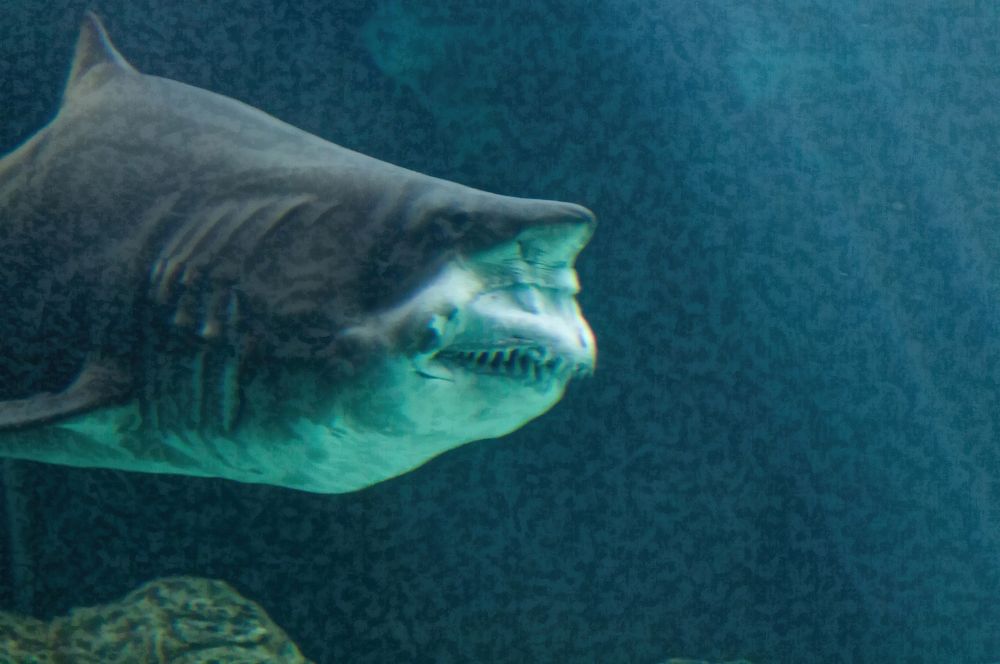
Bull sharks employ a variety of strategies to capture their prey. These feeding techniques and behaviors are crucial to their survival, allowing them to optimally utilize their resources and adapt to different environments and prey availability.
Let’s explore some of these fascinating strategies.
Bump-and-Bite Technique
Bull sharks are known for using a unique feeding strategy known as the bump-and-bite technique. In this tactic, they use their snouts to bump into their prey, disorienting it before delivering a powerful bite. This strategy is particularly effective in murky water where visibility is low, allowing the bull shark to investigate potential prey using its limited vision.
This bump-and-bite technique showcases the bull shark’s strategic thinking and adaptability in hunting. By disorienting their prey before attacking, bull sharks increase their chances of a successful hunt, proving their prowess as top predators in their habitats.
Regurgitation for Escape
In addition to their unique hunting techniques, bull sharks have another surprising behavior – they can regurgitate the food in their stomachs to create a distraction, allowing them to escape from predators or stressful situations. This behavior offers a fascinating glimpse into the bull shark’s survival strategies.
Regurgitation acts as a distraction, creating confusion and providing a momentary advantage for the bull shark to make its escape. This ability to adapt their behavior to deal with threats further highlights the bull shark’s survival skills and their adaptability to different situations.
Seasonal and Environmental Influences on Diet
The diet and feeding habits of bull sharks are influenced not just by their immediate environment, but also by seasonal changes and human-induced factors. For instance, studies have shown that bull shark numbers at feeding sites in Fiji decrease over the course of a calendar year, with the fewest sharks counted in November. This suggests that seasonal changes may influence the availability of their prey, affecting their feeding habits.
Pollution and habitat destruction also pose significant threats to bull sharks by reducing the availability of food and shrinking the areas where they can breed and nurse their young. These human-induced changes can have far-reaching implications on the diet and survival of bull sharks, highlighting the importance of conservation efforts to preserve their habitats.
Juvenile vs. Adult Bull Shark Diets
The diet of bull sharks varies with age. Juvenile bull sharks typically stay in rivers, using mangroves for protection, but rely more on saltmarsh habitats for nutrition. These habitats provide a rich source of small fish and invertebrates, which are easier for younger sharks to catch and consume.
As they age and grow, female bull sharks gradually move towards the mouth of the estuary, preying on larger fish and species dependent on saltmarsh habitats. Male bull sharks, adult bull sharks, with their powerful jaws and larger size, are capable of capturing and consuming a wider range of prey, including other sharks, marine mammals, and even terrestrial mammals when available. This shift in diet is a critical aspect of their life cycle, reflecting their growth and changing nutritional needs.
Energy Conservation and Feeding Efficiency
Bull sharks have developed various strategies to conserve energy and optimize their feeding efficiency. For instance, they use tidal currents to assist in their movement, reducing the energy required for swimming. Young bull sharks often remain in shallow waters where prey is more abundant, limiting the energy expended on hunting.
Bull sharks also adjust their rate of feeding depending on the amount of available prey, optimizing energy intake. In times of food scarcity, their bodies slow down digestion in order to conserve resources for survival. This adaptive response helps them endure periods of limited food supply. These strategies highlight the bull shark’s adaptability and resilience, enabling them to survive in diverse environments and under varying conditions.
Human Interactions and Impact on Diet
Human activities have a significant impact on the bull shark population and their food sources. Some of the main threats to these sharks include:
-
Fishing
-
Habitat degradation
-
Climate change
-
Beach protection programs
These activities can affect their diet and overall health.
Let’s explore how these factors impact bull sharks.
Scavenging Near Fishing Areas
Bull sharks often scavenge near fishing boats, leading to increased encounters with humans and a higher possibility of shark attacks. This behavior can increase their risk of being caught as bycatch, contributing to their declining populations. Additionally, bull sharks may exhibit site fidelity to provisioning sites, returning regularly to feed.
While scavenging near fishing areas can provide an abundant source of food, it also exposes bull sharks to risks, including injury from fishing gear and potential capture. This demonstrates the complex relationship between human activities and the feeding habits of dangerous sharks like bull sharks, as what can be a source of easy food can also become a source of danger.
Effects of Pollution and Overfishing
Overfishing poses a significant threat to bull sharks by reducing the availability of prey, impacting their food sources. When fish populations are depleted due to overfishing, bull sharks may struggle to find enough food, potentially leading to a decline in their populations.
Additionally, pollution, particularly in coastal and estuarine habitats where bull sharks often reside, can have detrimental effects on their health and the availability of their prey. Chemical pollutants can contaminate their food sources, leading to potential health issues, while plastic pollution can result in ingestion and entanglement. These human-induced factors highlight the urgent need for conservation efforts to protect these magnificent creatures and their habitats.
Summary
To sum up, bull sharks boast a diverse diet, feeding on a variety of prey from bony fish, sea turtles, and marine mammals to smaller sharks, crustaceans, and even terrestrial mammals. Their feeding habits and diet are influenced by various factors, including their age, environmental conditions, and human-induced changes. These fascinating creatures demonstrate remarkable adaptability and resilience, employing unique feeding strategies and conserving energy to survive in diverse habitats. However, human activities pose significant threats to their survival, underscoring the need for concerted conservation efforts to protect these magnificent predators and preserve the balance of our marine ecosystems.
Frequently Asked Questions
What do bull sharks eat?
Bull sharks have a diverse diet including bony fish, sea turtles, marine mammals, smaller sharks, crustaceans, mollusks, birds, and even terrestrial mammals. This makes them formidable and opportunistic predators.
How do bull sharks hunt their prey?
Bull sharks hunt their prey using various tactics, including the bump-and-bite technique, where they use their snouts to disorient and then bite the prey. This allows them to efficiently catch their target.
Are bull sharks affected by human activities?
Yes, human activities such as fishing, habitat degradation, and climate change pose serious threats to bull sharks, affecting their diet and overall health. It's essential to consider these factors in conservation efforts.
What's the difference between the diet of juvenile and adult bull sharks?
Juvenile bull sharks feed on small fish and invertebrates in saltmarsh habitats, whereas adult bull sharks prey on larger fish and species dependent on saltmarsh habitats as they grow. This dietary shift occurs as the sharks age and move towards the estuary.
How do bull sharks conserve energy?
Bull sharks conserve energy by using tidal currents to reduce the energy required for swimming and adjusting their feeding rate based on the availability of prey. They also slow down their digestion when food is scarce.
Recent Posts






